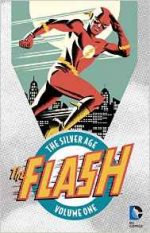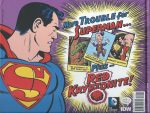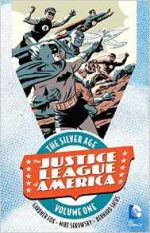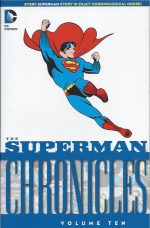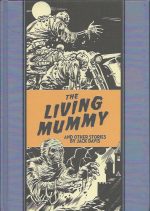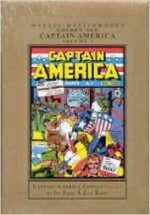
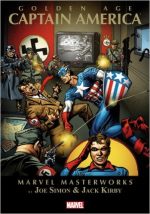
By Joe Simon & Jack Kirby and various (Marvel Comics)
ISBN: 0-7851-1619-2 (HC);Â 978-0785157939 (PB)
Win’s Christmas Gift Recommendation: An Evergreen Hit… 8/10
The success of DC’s Archive imprint – luxury hardback chronological collections of rare, expensive and just plain old items out of their mammoth back-catalogue – gradually resulted in a shelf-buckling array of Golden and Silver Age volumes which paid worthy tribute to the company’s grand past and still serves a genuine need amongst fans of old comics who don’t own their own software company or Money Bin. Even if production of the series seems to have been generally sidelined in recent months…
From DC’s tentative beginnings in the 1990’s Marvel, Dark Horse and other publishers have since pursued this (presumably) lucrative avenue, perhaps as much a sop to their most faithful fans as an exercise in expansion marketing.
DC’s electing to spotlight not simply their World Branded “Big Guns†but also those idiosyncratic yet well-beloved collector nuggets – such as Doom Patrol, Sugar and Spike or Kamandi – was originally at odds with Marvel’s policy of only releasing equally expensive editions of major characters from “the Marvel Age of Comicsâ€, but eventually their Timely and Atlas era material joined the procession…
A part of me understands Marvel’s initial reluctance: sacrilegious as it may sound to my fellow fan-boys, the simple truth is that no matter how venerable and beloved those early stories are, no matter how their very existence may have lead to true classics in a later age, in and of themselves, most early Marvel tales – and other “Golden Age Greats†– just aren’t that good by today’s standards.
This Marvel Masterworks Captain America – now also available as an ebook – volume  reprints more or less the complete contents of the first four issues of his original title (spanning March to June 1941) and I stress this because all the leading man’s adventures have often been reprinted before, most notably in a shoddy, infamous yet expensive 2-volume anniversary boxed set issued in 1991.
However, the groundbreaking and exceptionally high quality material by Joe Simon & Jack Kirby seen here is not really the lure … the real gold nuggets for us old sods are those rare back-up features from the star duo and their small team of talented youngsters. Reed Crandall, Syd Shores, Alex Schomburg and the rest worked on main course and filler features such as Hurricane, the God of Speed and Tuk, Caveboy; strips barely remembered yet still brimming with the first enthusiastic efforts of creative legends in waiting.
Captain America was devised at the end of 1940 and boldly launched in his own monthly title from Timely – the company’s original name – with none of the customary cautious shilly-shallying.
Captain America Comics, #1 was cover-dated March 1941 and was an instant monster, blockbuster smash-hit. Cap was instantly the absolute and undisputed star of Timely’s “Big Three†– the other two being the Human Torch and Sub-Mariner – and one of the very first to fall from popularity at the end of the Golden Age.
Today, the huge 1940s popularity of the other two just doesn’t translate into a good read for modern consumers – excluding, perhaps, those far-too-few Bill Everett crafted Sub-Mariner yarns.
In comparison to their contemporaries at Quality, Fawcett, National/All American and Dell, or Will Eisner’s The Spirit newspaper strip, the standard of most Timely periodicals was woefully lacklustre in both story and most tellingly, art. That they survived and prospered is a Marvel mystery, but a clue might lie in the sheer exuberant venom of their racial stereotypes and heady fervour of jingoism at a time when America was involved in the greatest war in world history…
I suspect given the current tone of the times politically, such sentiments might be less controversial now than they have been for quite a while…
However, the first ten Captain America Comics are the most high-quality comics in the fledgling company’s history and I can’t help but wonder what might have been had National (née DC) been wise enough to hire Simon & Kirby before they were famous, instead of after that pivotal first year?
Of course we’ll never know and though they did jump to the majors after a year, their visual dynamic became the aspirational style for superhero comics at the company they left and their patriotic creation became the flagship icon for them and the entire industry.
This compelling and exceptional volume opens with ‘Case No. 1: Meet Captain America’ by Simon & Kirby (with additional inks by Al Liederman) wherein we first see how scrawny, enfeebled young patriot Steven Rogers, continually rejected by the US Army, is recruited by the Secret Service.
Desperate to counter a wave of Nazi-sympathizing espionage and sabotage, this passionate man is invited to become part of a clandestine experiment intended to create physically perfect super-soldiers. However, when a vile Nazi agent infiltrates the project and murders its key scientist, Rogers became the only successful graduate and America’s not-so-secret weapon.
Sent undercover as a simple private he soon encounters Bucky Barnes: a headstrong, orphaned Army Brat who becomes his sidekick and costumed confidante. All of that is perfectly packaged into mere seven-and-a-half pages, and the untitled ‘Case No. 2’ takes just as long to spectacularly defeat Nazi showbiz psychics Sando and Omar as they spread anxiety and fear amongst the Americans.
‘Captain America and the Soldier’s Soup’ is a rather mediocre and unattributed prose tale promptly followed by a sinister 16-page epic ‘Captain America and the Chess-board of Death’ with our heroes thrashing more macabre murdering Nazi malcontents before the groundbreaking introduction of the nation’s greatest foe…
Solving ‘The Riddle of the Red Skull’ proves to be a thrill-packed, horror-drenched master-class in comics excitement…
The first of the B-features follows next as Hurricane (Son of Thor) and the last survivor of the Greek Gods – don’t blame me; that’s what it says – sets his super-fast sights on ‘Murder Inc.’ in a rip-roaring but clearly rushed battle against fellow-immortal Pluto (so not quite the last god either; nor exclusively Norse or Greek…) who is once more using mortals to foment pain, terror and death.
Hurricane was a rapid reworking and sequel to Kirby’s ‘Mercury in the 20th Century’ from Red Raven Comics #1 (August 1940) whereas ‘Tuk, Caveboy: Stories from the Dark Ages’ is all-original excitement as a teenaged boy in 50,000 BC and raised by a beast-man determines to regain the throne of his antediluvian kingdom Attilan from the usurpers who stole it.
This is an imaginative barbarian spectacular that owes as much to Tarzan as The Land that Time Forgot but it certainly delivers the thrills we all want…
Historians believe Kirby pencilled this entire issue and although no records remain, inkers as diverse as Liederman, Crandall, Bernie Klein, Al Avison, Al Gabrielle, Syd Shores and others may have been involved in this and subsequent issues…
Captain America Comics #2 screamed onto the newsstands a month later and spectacularly opened with monster mash-up ‘The Ageless Orientals Who Wouldn’t Die’, blending elements of horror and jingoism into a terrifying thriller with a ruthless American capitalist exposed as the true source of a rampage against the nation’s banks…
‘Trapped in the Nazi Stronghold’ sees Cap and Bucky in drag and in Europe to rescue a pro-British financier kidnapped by the Nazis whilst ‘Captain America and the Wax Statue that Struck Death’ returned to movie-thriller themes in the tale of a macabre murderer with delusions of world domination.
The Patriotic Pair then deal with saboteurs in the prose piece ‘Short Circuit’ before Tuk tackles monsters and mad priests in ‘The Valley of the Mist’ (by either the King and a very heavy inker or an unnamed artist doing a passable Kirby impression) and Hurricane – now “Master of Speed†swiftly and spectacularly expunges ‘The Devil and the Green Plague’ in the fetid heart of the Amazon jungles.
17-page epic ‘The Return of the Red Skull’ led in #3 – knocking Adolf Hitler off the cover-spot he’d hogged in #1 and #2 – with Kirby opening up his layouts to utterly enhance the graphic action with a veritable production line of creators (including Ed Herron, Martin A, Burnstein, Howard Ferguson, William Clayton King, and possibly George Roussos, Bob Oksner, Max Elkan and Jerry Robinson) joining the art team.
Whilst eye-shattering scale and spectacle unite with non-stop action and eerie mood as key components of the Sentinel of Liberty’s exploits horror elements dominated in ‘The Hunchback of Hollywood and the Movie Murder’ as a patriotic film is plagued by sinister “accidentsâ€.
Stan Lee debuts with text tale ‘Captain America Foils the Traitor’s Revenge’ before Simon & Kirby – and friends – recount ‘The Queer Case of the Murdering Butterfly and the Ancient Mummies’; blending eerie Egyptian antiquities with a thoroughly modern costumed psychopath.
Then Tuk (drawn by either Mark Schneider – or perhaps Marcia Snyder) reaches ‘Atlantis and the False King’ after which Kirby contributes a true tale in ‘Amazing Spy Adventures’ before Hurricane confronts ‘Satan and the Subway Disasters’ with devastating and final effect…
The final issue in this fabulous chronicle opens with ‘Captain America and the Unholy Legion’ as the star-spangled brothers-in-arms crush a conspiracy of beggars terrorising the city, before taking on ‘Ivan the Terrible’ in a time-bending vignette and thereafter solving ‘The Case of the Fake Money Fiends’. The all-action extravaganzas culminate in magnificent fashion when our heroes then expose the horrendous secret of ‘Horror Hospital’…
After Lee-scripted prose-piece ‘Captain America and the Bomb Sight Thieves’ young Tuk defeats ‘The Ogre of the Cave-Dwellers’ and Hurricane brings down a final curtain on ‘The Pirate and the Missing Ships’.
An added and very welcome bonus for fans is the inclusion of all the absolutely beguiling house-ads for other titles, contents pages, Sentinels of Liberty club bulletins and assorted pin-ups…
Although lagging far behind DC and despite in many ways having a much shallower vintage well to draw from, with this particular tome at least the House of Ideas has a book that will always stand shoulder to shoulder with the very best that the Golden Age of Comics could offer and should be on every fan’s “never-miss†bookshelf.
© 1941, 2005, 2012 Marvel Characters, Inc. All rights reserved.


